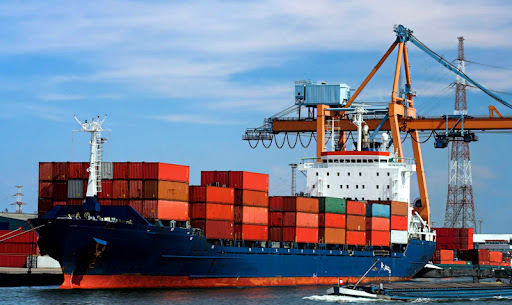
Shipping Industry in India: Prospects for Foreign Investors

India’s strategic location, enveloped by the world’s busiest maritime route in the Indian Ocean, marks the importance of its shipping industry which facilitates 95 percent of India’s international trade by volume. Therefore India is according the highest priority to the development of its maritime sector and is seeking investments to the tune of US$81 billion. India allows upto 100 percent FDI under automatic route for port and harbor construction projects.
NEW DELHI : The Indian subcontinent, with a vast coastline of 7,517 kms finds itself in a particularly strategic location, surrounded by the waters of the Indian Ocean Region (IOR), which support around 80 percent of world’s maritime oil trade. This vast coastline enclosed by the world’s busiest trade route forms the rationale for India’s economic dependance on maritime sector.
India’s shipping industry is the linchpin of the Indian trade and commerce, both by value as well as volume. According to data from Ministry of Ports, Shipping and Waterways (MoPSW), around 95 percent of India’s international trading volume and 70 percent of total trade value is dependent on the maritime channel.
In fact, India’s maritime sector will determine the success of “Make in India” initiative, which depends as much on its connectivity and supply enabling prowess, as on its manufacturing capacity. As of April 2020, India’s maritime fleet strength stands at 1431.
Ports in India: Existing infrastructure and capacity
India has 12 major, and 205 notified minor and intermediate ports. Among major ports, while six of them are on the eastern coast, the rest are on the western coast. They are under the jurisdiction of the federal government. The non-major ports come under the jurisdiction of respective state governments’ maritime boards.
Under the National Perspective Plan for Sagarmala, six new mega ports with world-class infrastructure are also being developed in the country, with Vadhavan port(in Palghar district of coastal Konkan), Paradip port (in Jagatsinghpur district of Odisha state), and Kandla port (in Kutch district of Gujarat state) taking the lead.
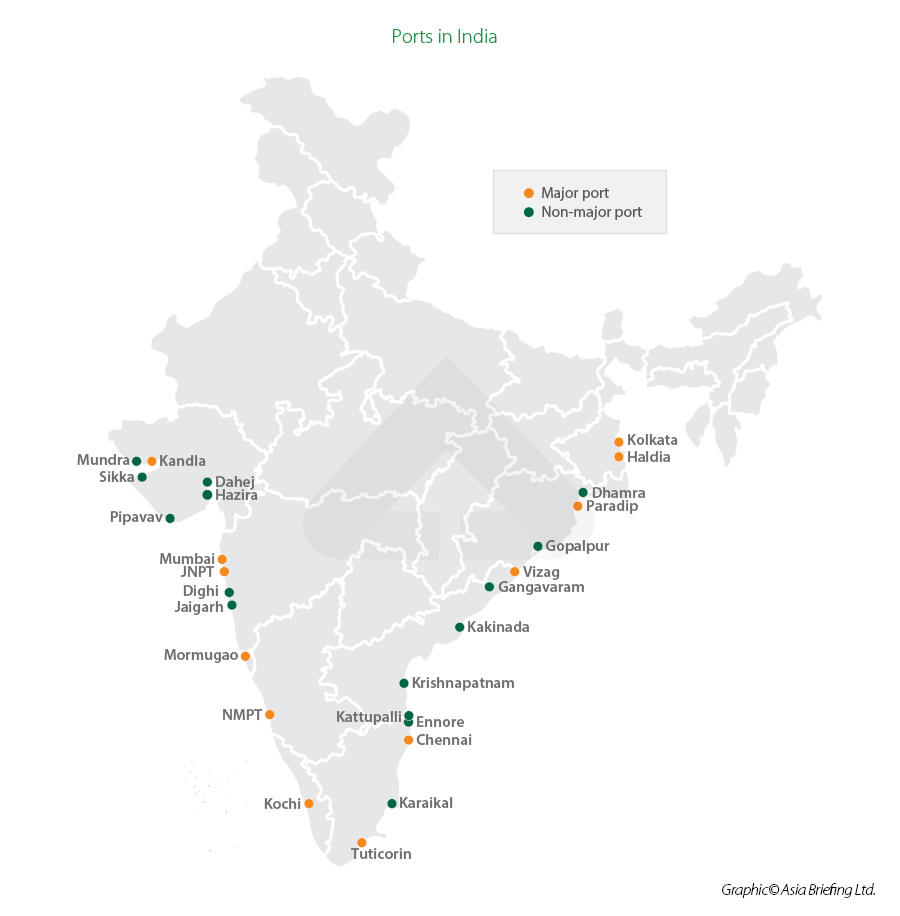
Jawaharlal Nehru Port Trust (JNPT) in the Maharashtra state is the largest major container handling port in India, while Mundra port in Gujarat is the largest private port. It has been reported that the utilization rates of these major ports in India, including JNPT and Kandla, are much higher than the world average. The average turnaround time, that is the time between the arrival and departure of a vessel, at major Indian ports has decreased at a rapid pace from 87 hours in financial year (FY) 2016 to the lowest at 59.51 hours in FY19. The average turnaround time for FY21 was 62.16 hours.
In FY20, the 12 major ports in India handled 704.93 million tonnes (MT) of cargo traffic, and held an annual capacity of 1,534.91 MT in FY20. The cargo traffic at major ports stood at 672.61 MT during FY21. It is estimated that by 2025, the cargo traffic at Indian ports will surpass 2500 MT per annum, against the current capacity of approximately 1500 MT. Therefore, accelerated development of the sector for capacity expansion is indispensable. India is working on capacity expansion as well as new port development to reach annual capacity of over 3300 MT.
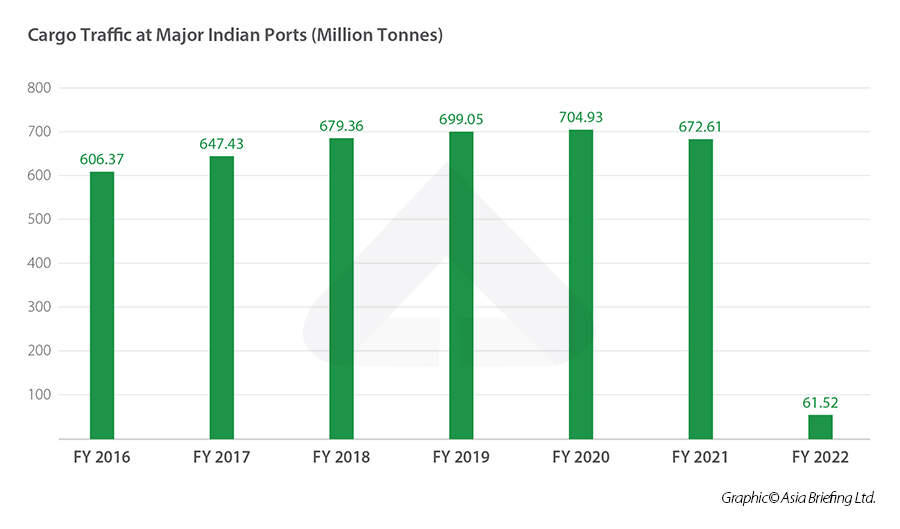
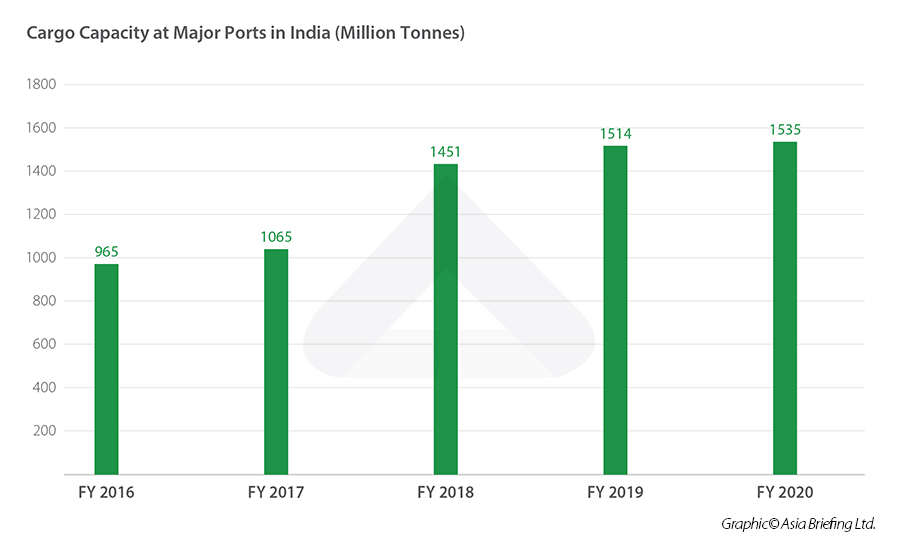
On the contrary, the cumulative capacity of the non-major ports was 613 MT in FY20 and 575 MT in FY21. Thus, in FY21, while the major ports claimed 54 percent of market share, the share of non-major ports has charted an upward trajectory, growing from 39 percent in FY12 to 46 percent in FY21. This implies that a major chunk of cargo traffic has shifted from major to non-major ports, registering a compound annual growth rate (CAGR) of 4.3 percent in the last five years.
An analysis of the composition of cargo at the major ports reveals that solid cargo (41.7 percent) contributes the largest share to all traffic handled at major ports in India, followed by liquid cargo (37.5 percent) and containers (20.8 percent). Solid, liquid and container cargo traffic in April 2021 stood at 21.3 MT, 17.9 MT and 8.8 MT, respectively.
Under solid cargo, coal (23.1 percent) claimed the lion’ share in FY20, followed by iron ore (5.8 percent) and fertilizers (2.2 percent). The remaining 10. 6 percent share is comprised of other cargo.
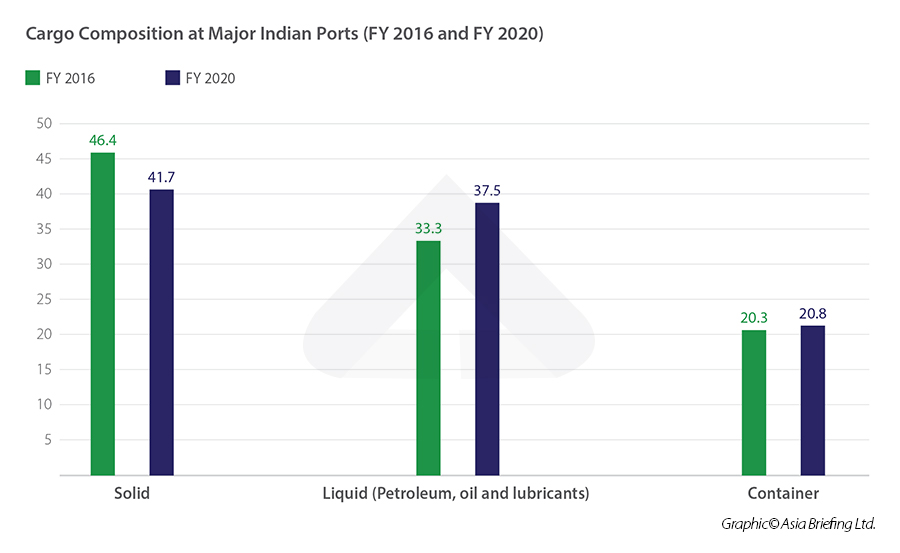
Investment opportunities in the Indian shipping industry
Keeping in mind the significant contribution made by the maritime sector in facilitating Indian trade overseas, the Indian government has streamlined and expanded its attention as well as investments towards the sector with focus on developing, maintaining, and operating ports, inland waterways, and shipbuilding in India.
India allows up to 100 percent foreign direct investment (FDI) under the automatic route for projects related to the construction and maintenance of ports and harbors. In the last two decades, Indian ports have attracted a cumulative FDI amounting to INR 122 billion (US$1.64 billion).
Under the Sagarmala Project (2015-2035), over 574 new projects have been identified for implementation by 2035 and an investment to the tune of INR 6 trillion (US$81 billion) has been invited, including from the private sector, towards areas of areas of port modernization and new port development, port connectivity enhancement, port-linked industrialization, and coastal community development. As of September 30, 2019, a total of 121 projects at a cost of INR 302.28 billion (US$4 billion) have been completed and 201 projects at a cost of INR 3.09 trillion (US$42 billion) are under implementation.
With focus on clean renewable energy source in the sector, along with augmentation of related infrastructure for both trade and tourism, India is being pitched as the most preferred investment destination among global players.
In the recently concluded Maritime India Summit in March 2021, India has announced 400 new projects in the sector with an investment potential of INR 2.25 trillion (US$30 billion) for the development of Indian coastline. India has also released a 10-year maritime sector blueprint “Vision India 2030” which outlines India’s vision for the development of the sector. This vision includes setting up smart ports, creation of a Maritime Development Fund (MDF) with a corpus of INR 250 billion (US$3.36 billion) and establishment of a pan-India port regulatory authority.
Along with the development of ports and waterways, India is also actively working on increasing its shipbuilding capacity as well as its ship repair infrastructure.
Policy support to the Indian shipping industry
- In Federal Budget 2021-22, the government has announced subsidy worth INR 16.24 billion (US$218.40 million) to Indian shipping companies to encourage merchant ship flagging.
- The Major Port Authorities Act, 2021 has also been passed to align governance models in these ports with international best practices.
- A revised investor friendly Model Concession Agreement (MCA) has been put in place that will help in bringing transparency and uniformity to contractual agreements that major ports would enter with investors for projects under the build, operate and transfer model.
- Since there has been an increasing inclination towards the privatization of the shipping industry with ports shifting to landlord model, the MoPSW launched a dispute redressal portal, ‘SAROD-Ports (Society for Affordable Redressal of Disputes – Ports) in 2020 to help develop confidence in the private sector. The Ministry also launched an indigenous software solution for vessel traffic services (VTS) and vessels traffic monitoring systems (VTMS) in the same year, making strides towards digitization of the sector.
- A 10-year tax holiday will be provided for businesses engaged in developing, maintaining and operating ports, inland waterways and inland ports.
Keeping in mind the significant contribution made by the maritime sector in facilitating Indian trade overseas, the Indian government has streamlined and expanded its attention as well as investments towards the sector with focus on developing, maintaining, and operating ports, inland waterways, and shipbuilding in India.
India allows up to 100 percent foreign direct investment (FDI) under the automatic route for projects related to the construction and maintenance of ports and harbors. In the last two decades, Indian ports have attracted a cumulative FDI amounting to INR 122 billion (US$1.64 billion).
Under the Sagarmala Project (2015-2035), over 574 new projects have been identified for implementation by 2035 and an investment to the tune of INR 6 trillion (US$81 billion) has been invited, including from the private sector, towards areas of areas of port modernization and new port development, port connectivity enhancement, port-linked industrialization, and coastal community development. As of September 30, 2019, a total of 121 projects at a cost of INR 302.28 billion (US$4 billion) have been completed and 201 projects at a cost of INR 3.09 trillion (US$42 billion) are under implementation.
With focus on clean renewable energy source in the sector, along with augmentation of related infrastructure for both trade and tourism, India is being pitched as the most preferred investment destination among global players.
In the recently concluded Maritime India Summit in March 2021, India has announced 400 new projects in the sector with an investment potential of INR 2.25 trillion (US$30 billion) for the development of Indian coastline. India has also released a 10-year maritime sector blueprint “Vision India 2030” which outlines India’s vision for the development of the sector. This vision includes setting up smart ports, creation of a Maritime Development Fund (MDF) with a corpus of INR 250 billion (US$3.36 billion) and establishment of a pan-India port regulatory authority.
Along with the development of ports and waterways, India is also actively working on increasing its shipbuilding capacity as well as its ship repair infrastructure.
Source : India Briefing


